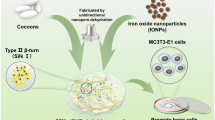Abstract
In current work, the porous 3D bone substitute scaffolds based on the chitosan, gelatin and polycaprolactone using freeze drying technique are introduced. SEM images showed that all the scaffolds had porous structures with average pore diameter size of 23–183 µm. The results of FTIR demonstrated the successful blending of scaffolds. Also, the compression test results determined that the presence of polycaprolactone effectively improved the mechanical properties of the chitosan/gelatin/polycaprolactone scaffolds, having the highest strength, i.e. 24.5 MPa and highest modulus, i.e. 3.86 MPa. The degradation behavior obtained under lysozyme/PBS solutions revealed that the chitosan/gelatin scaffold had a faster degradation rate rather than other scaffolds. MTT assay as well as cell attachment analysis confirmed the appropriate cell viability and cell adhesion on the scaffolds. Taken together, the scaffolds developed in this study may find potential application in bone substitution applications.

Similar content being viewed by others
References
A. Hajizadeh, S. Aziziaπ, S. Tajvar, and M. Solaymanifar, Nano/Micro Structured Scaffolds in Tissue Engineering: From Vascularization Viewpoint, Amirkabir University of Technology (Tehran Polytechnic), 1st ed., 1395.
R. C. Dutta, M. Dey, A. K. Dutta, and B. Basu, Biotechnol. Adv., 35, 240 (2017).
L. H. Chong, N. Z. Zarith, and N. Sultana, Poly(Caprolactone)/Chitosan-based Scaffold using Freeze Drying Technique for Bone Tissue Engineering Application, 10th Asian Control Conference (ASCC), 2015.
J.-B. Julla, R. Ballaire, T. Ejlalmanesh, J.-F. Gautier, N. Venteclef, and F. Alzaid, in Lipid-Activated Nuclear Receptors, Methods in Molecular Biology, Humana Press, New York, 2018, Vol. 1951, pp 33–48.
K. Saeed and S.-Y. Park, Iranian J. Chem. Chem. Eng., 29, 77 (2010).
K. Maji, S. Dasgupta, K. Pramanik and A. Bissoyi, Int. J. Biomater., 2016, 9825659 (2016).
A. Sarasam and S. V. Madihally, Biomaterials, 26, 5500 (2005).
M. Bohner and J. Lemaitre, Biomaterials, 30, 2175 (2009).
H. Pan, X. Zhao, B. W. Darvell, and W. W. Lu, Acta Biomater., 6, 4181 (2010).
A. R. Naqshbandi, I. Sopyan, and Gunawan, Recent Patents Mater. Sci., 6, 238 (2013).
S. Sánchez-Salcedo, D. Arcos, and M. Vallet-Regí, Key Eng. Mater., 2, 19 (2008).
S. Gautam, C.-F. Chou, A. K. Dinda, P. D. Potdar, and N. C. Mishra, J. Mater. Sci., 49, 1076 (2014).
E. Bolaina-Lorenzo, C. Martínez-Ramos, M. Monleón-Pradas, W. Herrera-Kao, J. V Cauich-Rodríguez, and J. M Cervantes-Uc, Biomed. Mater., 12, 015008 (2017).
L. Kundanati, S. K. Singh, B. B. Mandal, T. G. Murthy, N. Gundiah, and N. M. Pugno, Int. J. Mol. Sci., 17, 238 (2016).
S. Moeini, M. R. Mohammadi, and A. Simchi, Bioact. Mater., 2, 1 (2017).
K. Maji, S. Dasgupta, K. Pramanik, and A. Bissoyi, Mater. Sci. Eng. C, 86, 83 (2018).
K. Maji, S. Dasgupta, B. Kundu, and A. Bissoyi, J.Biomater. Sci., Polym. Ed., 26, 1190 (2015).
S. Mohamed and B. H. Shamaz, Int. J. Dent. Oral Health, 1, 15 (2015).
T. Niemelä and M. Kellomäki, in Bioactive Glasses, Woodhead Publishing, Cambridge, 2011, pp 227–245.
I. Vroman and L. Tighzert, Materials, 2, 307 (2009).
A. Banerjee, K. Chatterjee, and G. Madras, Mater. Sci. Technol., 30, 567 (2014).
F. F. Azhar, A. Olad, and R. Salehi, Des. Monomers Polym., 17, 654 (2014).
E. Díaz, I. Sandonis, and M. B. Valle, J. Nanomater., 2014, 1 (2014).
M. Peter, N. S. Binulal, S. V. Nair, N. Selvamurugan, H. Tamura, and R. Jayakumar, Chem. Eng. J., 158, 353 (2010).
G. S. Kozehkonan, M. Salehi, S. Farzamfar, H. Ghanbari, M. Adabi, and A. Amani, Nanomedicine J., 6, 311 (2019).
N. Thuaksuban, T. Nuntanaranont, W. Pattanachot, S. Suttapreyasri, and L. K. Cheung, Biomed. Mater., 6, 015009 (2011).
J. Pourahmad and A. Salimi, Iranian J. Pharm. Res., 14, 679 (2015).
G. M. Şerban, I. B. Mănescu, D. R. Manu, and M. Dobreanu, Acta Medica Marisiensis, 64, 83 (2018).
M. PULAT, The Eurasia Proceedings of Educational & Social Sciences (EPESS), 6, 111 (2019).
M. Peter, N. Ganesh, N. Selvamurugan, S. V. Nair, T. Furuike, H. Tamura, and R. Jayakumar, Carbohydr. Polym., 80, 687 (2010).
Acknowledgments
The authors wish to acknowledge Esfarayen University of Technology (EUT) and Sadjad University of Technology for all supports throughout this cooperative project.
Author information
Authors and Affiliations
Corresponding author
Additional information
Publisher’s Note
Springer Nature remains neutral with regard to jurisdictional claims in published maps and institutional affiliations.
Rights and permissions
About this article
Cite this article
Haghbin, M., Esmaeilzadeh, J. & Kahrobaee, S. Freeze Dried Biodegradable Polycaprolactone/Chitosan/Gelatin Porous Scaffolds for Bone Substitute Applications. Macromol. Res. 28 (Suppl 1), 1232–1240 (2020). https://doi.org/10.1007/s13233-020-8170-5
Received:
Revised:
Accepted:
Published:
Issue Date:
DOI: https://doi.org/10.1007/s13233-020-8170-5




